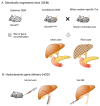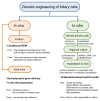Recent Advances in Implantation-Based Genetic Modeling of Biliary Carcinogenesis in Mice
- PMID: 34064809
- PMCID: PMC8151177
- DOI: 10.3390/cancers13102292
Recent Advances in Implantation-Based Genetic Modeling of Biliary Carcinogenesis in Mice
Abstract
Epithelial cells in the biliary system can develop refractory types of cancers, which are often associated with inflammation caused by viruses, parasites, stones, and chemicals. Genomic studies have revealed recurrent genetic changes and deregulated signaling pathways in biliary tract cancer (BTC). The causal roles have been at least partly clarified using various genetically engineered mice. Technical advances in Cre-LoxP technology, together with hydrodynamic tail injection, CRISPR/Cas9 technology, in vivo electroporation, and organoid culture have enabled more precise modeling of BTC. Organoid-based genetic modeling, combined with implantation in mice, has recently drawn attention as a means to accelerate the development of BTC models. Although each model may not perfectly mimic the disease, they can complement one another, or two different approaches can be integrated to establish a novel model. In addition, a comparison of the outcomes among these models with the same genotype provides mechanistic insights into the interplay between genetic alterations and the microenvironment in the pathogenesis of BTCs. Here, we review the current status of genetic models of BTCs in mice to provide information that facilitates the wise selection of models and to inform the future development of ideal disease models.
Keywords: biliary tract cancer; genetically engineered mouse; hydrodynamic injection; implantation; nude mouse; organoid; orthotopic model; syngeneic.
Conflict of interest statement
The authors declare no conflict of interest.
Figures






Similar articles
-
Two-Way Development of the Genetic Model for Endometrial Tumorigenesis in Mice: Current and Future Perspectives.Front Genet. 2021 Dec 9;12:798628. doi: 10.3389/fgene.2021.798628. eCollection 2021. Front Genet. 2021. PMID: 34956336 Free PMC article. Review.
-
Oncogenic KRAS-expressing organoids with biliary epithelial stem cell properties give rise to biliary tract cancer in mice.Cancer Sci. 2021 May;112(5):1822-1838. doi: 10.1111/cas.14703. Epub 2021 Mar 8. Cancer Sci. 2021. PMID: 33068050 Free PMC article.
-
Precision modeling of gall bladder cancer patients in mice based on orthotopic implantation of organoid-derived tumor buds.Oncogenesis. 2021 Apr 17;10(4):33. doi: 10.1038/s41389-021-00322-1. Oncogenesis. 2021. PMID: 33866327 Free PMC article.
-
Cell of origin in biliary tract cancers and clinical implications.JHEP Rep. 2021 Jan 19;3(2):100226. doi: 10.1016/j.jhepr.2021.100226. eCollection 2021 Apr. JHEP Rep. 2021. PMID: 33665585 Free PMC article. Review.
-
Bile acid accelerates erbB2-induced pro-tumorigenic activities in biliary tract cancer.Mol Carcinog. 2015 Jun;54(6):459-72. doi: 10.1002/mc.22118. Epub 2013 Dec 3. Mol Carcinog. 2015. PMID: 24839254
Cited by
-
Prevalence and predictive value of sarcopenia in surgically treated cholangiocarcinoma: a comprehensive review and meta-analysis.Front Oncol. 2024 Mar 19;14:1363843. doi: 10.3389/fonc.2024.1363843. eCollection 2024. Front Oncol. 2024. PMID: 38571501 Free PMC article.
-
AMPAR receptor inhibitors suppress proliferation of human small cell lung cancer cell lines.Thorac Cancer. 2023 Oct;14(29):2897-2908. doi: 10.1111/1759-7714.15075. Epub 2023 Aug 22. Thorac Cancer. 2023. PMID: 37605807 Free PMC article.
-
Twists and turns in Kras-driven tumor initiation.Aging (Albany NY). 2021 Nov 29;13(22):24477-24479. doi: 10.18632/aging.203726. Epub 2021 Nov 29. Aging (Albany NY). 2021. PMID: 34843447 Free PMC article. No abstract available.
-
Selecting an Appropriate Experimental Animal Model for Cholangiocarcinoma Research.J Clin Transl Hepatol. 2022 Aug 28;10(4):700-710. doi: 10.14218/JCTH.2021.00374. Epub 2022 Feb 11. J Clin Transl Hepatol. 2022. PMID: 36062286 Free PMC article. Review.
-
Two-Way Development of the Genetic Model for Endometrial Tumorigenesis in Mice: Current and Future Perspectives.Front Genet. 2021 Dec 9;12:798628. doi: 10.3389/fgene.2021.798628. eCollection 2021. Front Genet. 2021. PMID: 34956336 Free PMC article. Review.
References
Publication types
Grants and funding
LinkOut - more resources
Full Text Sources

